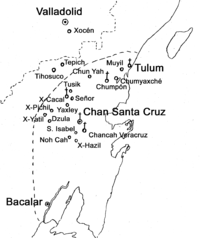This article has multiple issues. Please help improve it or discuss these issues on the talk page. (Learn how and when to remove these messages)
|
Chan Santa Cruz U Noh Kah Balam Nah Chan Santa Cruz | |||||||||
|---|---|---|---|---|---|---|---|---|---|
| 1849–1935 | |||||||||
|
Flag of Chan Santa Cruz | |||||||||
 Areas under the Mayas' control, c. 1870 | |||||||||
| Capital | Noh Kah Balam Nah Chan Santa Cruz | ||||||||
| Common languages | Mayan languages | ||||||||
| Halach Uinik (governor) | |||||||||
• 1849-1852 | Jose Maria Barrera | ||||||||
| Ahau K'atun Kiuik' (supreme general) | |||||||||
• Longest serving | Bernardino Cen | ||||||||
• Last | Francisco May | ||||||||
| History | |||||||||
• Established | 1849 | ||||||||
• Disestablished | 1935 | ||||||||
| |||||||||
| Today part of | Quintana Roo | ||||||||
Chan Santa Cruz was a late 19th-century indigenous Maya state in modern-day Quintana Roo. It was also the name of a shrine that served as the center of the Maya Cruzoob[note 1] religious movement, and of the town that developed around the shrine, now known as Felipe Carrillo Puerto. The town was historically the main center of what is now the Mexican state of Quintana Roo, and it acted as the de facto capital for the Maya during the Caste War of Yucatán.
Cite error: There are <ref group=note> tags on this page, but the references will not show without a {{reflist|group=note}} template (see the help page).
